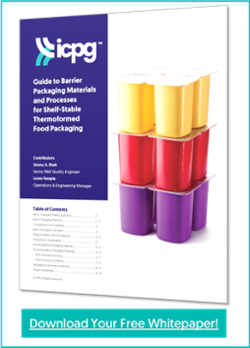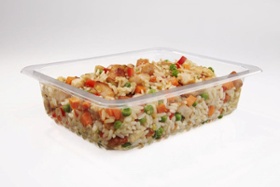 When it comes to food packaging materials, material science and engineering are playing an increasingly important role as packaging design and function evolve to compliment consumer desires for convenience, quality, healthfulness and safety. With more than 500 types of plastics available in the world, rapid advancements in material options with an emphasis on enhancements to key properties ranging from low temperature / high strength, to high temperature high / strength material, to enhanced barrier and high clarity materials, can make the process of material selection overwhelming.
When it comes to food packaging materials, material science and engineering are playing an increasingly important role as packaging design and function evolve to compliment consumer desires for convenience, quality, healthfulness and safety. With more than 500 types of plastics available in the world, rapid advancements in material options with an emphasis on enhancements to key properties ranging from low temperature / high strength, to high temperature high / strength material, to enhanced barrier and high clarity materials, can make the process of material selection overwhelming.
The selection of a specific material for a particular use is a very complex process with multiple options available based on material functionality, processability, availability, cost - and the list goes on! However, the decision can be simplified taking into consideration our below list of 10 factors to consider to determine the best material for your food packaging application.
1. Physical Properties
This is an important factor of a material where weight and thus the mass is critical. With the advances in materials and process technology, the packaging industry has been trending towards choosing light weight packaging materials and solutions that reduce the overall weight of plastics used in packaging solutions - not only reduce cost, but enhancing sustainability by saving energy during production and transportation, while reducing the amount of plastics used, and allowing for greater efficiencies in recycling. The prime example is milk packaging, which was first packaged in glass bottles, then wax coated paper to HDPE jugs, and recently in flexible pouches. Comparing glass bottles to todays’ flexible pouch, there is about a 99% weight reduction in the actual packaging material, resulting in a solution that provides cost efficiencies throughout the supply chain, is readily available, is safe and sterile, and is easy to handle and recycle.
Density and weight reduction, or "light-weighting," have become buzz words amongst the food packaging industry as brand owners look for ways to reduce the percentage of plastics used to improve the sustainability of their food packaging solutions. When it comes to plastics, polypropylene offers the lowest density and the lightest weight, offering up to a 17% weight reduction over alternative packaging solutions such as PET.
2. Mechanical Properties
 Evaluation of a material's mechanical properties means consideration of factors such as strength, stiffness, toughness, impact properties, etc. This is important for overall strength and rigidity of the final product. When it comes to food packaging, products often require a shelf life ranging from several days to, in some cases, several months. Thus, choosing a material, or materials with mechanical properties to support that desired shelf life is vitally important. Where materials have inherent mechanical properties, there are also additives and fillers available that enhances the material properties, coupled with this is another factor - thermal properties.
Evaluation of a material's mechanical properties means consideration of factors such as strength, stiffness, toughness, impact properties, etc. This is important for overall strength and rigidity of the final product. When it comes to food packaging, products often require a shelf life ranging from several days to, in some cases, several months. Thus, choosing a material, or materials with mechanical properties to support that desired shelf life is vitally important. Where materials have inherent mechanical properties, there are also additives and fillers available that enhances the material properties, coupled with this is another factor - thermal properties.
3. Thermal Properties
This means consideration of a material that provides key mechanical performance properties at low, room or elevated temperature. This is especially important when it comes to shelf stable food packaging. Depending on the application, the package may require specialty attributes such as high heat deflection for microwaveability, or low temperature impact properties for frozen applications. When choosing the right material for application that will undergo extreme temperatures by the end-user, it is important to understand the temperature tolerance of common food packaging materials, as putting a non-microwavable plastic container in the microwave, or even pouring hot liquid into a container that is not intended to withstand high heat conditions could be enough to distort the container and create a significant safety concern.
Polypropylene materials provide the widest performance selection when it comes to temperature range, with high resistance up to 260°F and low temperature impact properties that offer compatibility with freezer applications.
4. Chemical Properties
In food packaging, consideration of a material's chemical properties refers to selecting a material that is chemically stable for the desired food product. Foods that are highly acidic or highly alkaline will react differently with different packaging materials. In addition, the package may need to be stable or non-reactive to house hold chemicals that may come into contact with the package. This also comes into play at the point of sterilization, as the packaging materials may need to undergo one or multiple passes through sterilization systems before and after the food is packaged, in order to kill or eliminate transmissible agents such as fungi, bacteria, virus, etc. from the product and the package. Thus, the packaging material also needs to withstand sterilization techniques such as moist heat, dry heat, irradiation, and or by chemical methods such as hydrogen peroxide depending on the food and level of sterility requirement, all while maintaining structural integrity.
5. Optical Properties
 The optical properties or aesthetics of packaged materials is very important in today’s world where the customer is confronted by so many options - I think we can all remember a time when we bought something that wasn’t needed but it looked good on the store shelf or at the point of purchase. Compared to the past, when everything was canned or boxed, today clear packaging materials have brought upon a paradigm change, particularly in the food packaging industry where consumer interested has trended towards clarified materials enabling the consumer to see the actual food product that they are purchasing, from salads, to case-ready meats, applesauce, baby food, pet food, and ready to eat meals. With such requirements, it is also important to keep the food product safe from UV and visible light spectrum that can have a negative impact on certain products such as dairy food. This property is also dependent on how the packaging material is produced - which brings us to processing.
The optical properties or aesthetics of packaged materials is very important in today’s world where the customer is confronted by so many options - I think we can all remember a time when we bought something that wasn’t needed but it looked good on the store shelf or at the point of purchase. Compared to the past, when everything was canned or boxed, today clear packaging materials have brought upon a paradigm change, particularly in the food packaging industry where consumer interested has trended towards clarified materials enabling the consumer to see the actual food product that they are purchasing, from salads, to case-ready meats, applesauce, baby food, pet food, and ready to eat meals. With such requirements, it is also important to keep the food product safe from UV and visible light spectrum that can have a negative impact on certain products such as dairy food. This property is also dependent on how the packaging material is produced - which brings us to processing.
6. Processing Method - Thermoforming & Form Fill Seal
Today, most shelf-stable products are produced from materials that incorporate either an oxygen or moisture barrier extruded as a monolayer, extrusion laminated (with a custom barrier laminate) or multi-layer rollstock structure, then formed into the final part either on a thermoforming machine or a form fill seal line. While a basic requirement for packaging material used in these processes is to yield high output at a lower cost, it is important to understand how the material behaves in a particular process equipment with considerations to how it grips/holds, shrinks, trims, etc. as all materials behaves differently. Thus, it is important to first understand the key properties of the material and how it will perform under different processing techniques to meets the product specification and requirements.
7. Barrier properties - OTR & MVTR
Depending on the food product to be packaged, consideration needs to be given to the exact oxygen, moisture and aroma requirements during the material selection process. Achievement of OTR & MVTR is key to designing performance material structures with consideration to processing & sterilization techniques directly contribute to shelf-life performance. With advancements in barrier properties of the material technology and processing techniques, shelf-life performance can now be achieved using enhanced mono-material barrier structures, or a coextruded multi-layer barrier structure using materials such as EVOH that provide high OTR barrier properties.
8. Recycling
With recycling and sustainability of packaging becoming increasingly more important, improving the sustainability and recyclability of plastic food packaging has become a top priority for brand owners and CPGs. While most plastic materials used in food packaging are recyclable in theory, it has become more important to ensure that the materials are recyclable in practice and design in order to create closed loop systems and reduce plastic waste.
9. Regulatory Compliance
The U.S. Food and Drug Administration (FDA) heavily regulates all food packaging and controls what packaging can be used for food applications. The FDA not only regulates what material is used for direct food contact but also evaluates the environmental impacts of food packaging to ensure compliance with FDA and Environmental Protection Agency (EPA) regulations. This in turn is vital for food packaging materials to be in compliance with regulations with FDA regulations given considerations to known allergens, heavy metals and substances of high concern under California Proposition 65, REACH, ROHS, etc. Thus, it is important to understand the packaging materials, where the package is going to be used and what standards or regulations are important based on a case by case basis.
10. Cost
Ultimately, a key deciding factor for any new packaging project is cost. Thus, it becomes very important to understand the total cost of ownship through the entire supply chain. In most cases, the cost of raw materials account for about 50% of the finished cost. It therefore makes sense that the cost of the material becomes a major factor influencing material choice or process. However, we must note that use of a cheaper material will not always reduce the final cost of the component or product. Use of cheaper materials may be associated with higher processing cost, poor manufacturing efficiencies, higher scrap rates, product failures and poor quality.
Interested in learning more about barrier packaging materials and processes for your extended shelf-life food packaging applications? Download our whitepaper:




